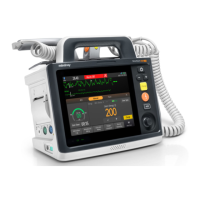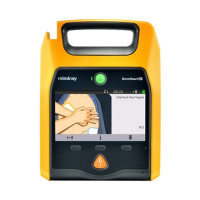10 - 1
10 Alarms
10.1 Alarm Introduction
• When multiple alarms of different priority levels occur simultaneously, the equipment selects the
alarm of the highest priority to light the alarm lamp and issue the alarm tone.
• When multiple alarms of different priority levels occur simultaneously and should be displayed in
the same area, the equipment only displays the messages of the highest priority alarm.
• When multiple physiological alarms of different priority levels occur simultaneously and should be
displayed in the same area, the equipment displays the high priority alarm, while the medium and
low priority alarms are displayed circularly.
• When multiple alarms of the same priority levels occur simultaneously, alarm messages are
displayed circularly.
• Lethal arrhythmia alarms, apnea, and SpO
2
Desat are exclusive high priority alarms. When these
alarms occur, the equipment only displays messages of exclusive alarms. Other high priority alarms
will not be displayed. When multiple exclusive alarms occur simultaneously, alarm messages are
displayed circularly.
10.2 Alarm Safety Information
• A potential hazard can exist if different alarm presets and default configuration settings are used for
the same or similar equipment in the same care area, for example an intensive care unit or cardiac
operating room.
• The equipments in the care area may each have different alarm settings to suit different patients.
Before starting monitoring, check that the alarm settings are appropriate for the patient. Always
make sure that necessary alarm limits are active and set according to the patient's clinical condition.
• Setting alarm limits to extreme values may cause the alarm system to become ineffective. For
example, high oxygen levels may predispose a premature infant to retrolental fibroplasia. Setting
the SpO
2
high alarm limit to 100% is equivalent to switching the alarm off the SpO
2
alarm.
• When the alarm sound is switched off, the equipment gives no alarm tones even if a new alarm
occurs. Be careful about whether to switch off the alarm sound or not. When the alarms are off or
while alarm audio is paused either temporarily or indefinitely, observe the patient frequently.
• When monitoring patients that are not continuously attended by a clinical operator, properly
configure the alarm system and adjust alarm settings as per the patient's condition.
• Do not exclusively rely on audible alarms for patient monitoring. Adjusting alarm volume to a low
level or turning off alarm sound may result in patient hazards. Always make sure that the audio
alarm volume level is adequate in your care environment. Always keep the patient under close
surveillance.
• In case of a temporary power failure, the equipment will save the alarms triggered before the power
failure. The information of saved alarms is unchanged saved after the power failure.

